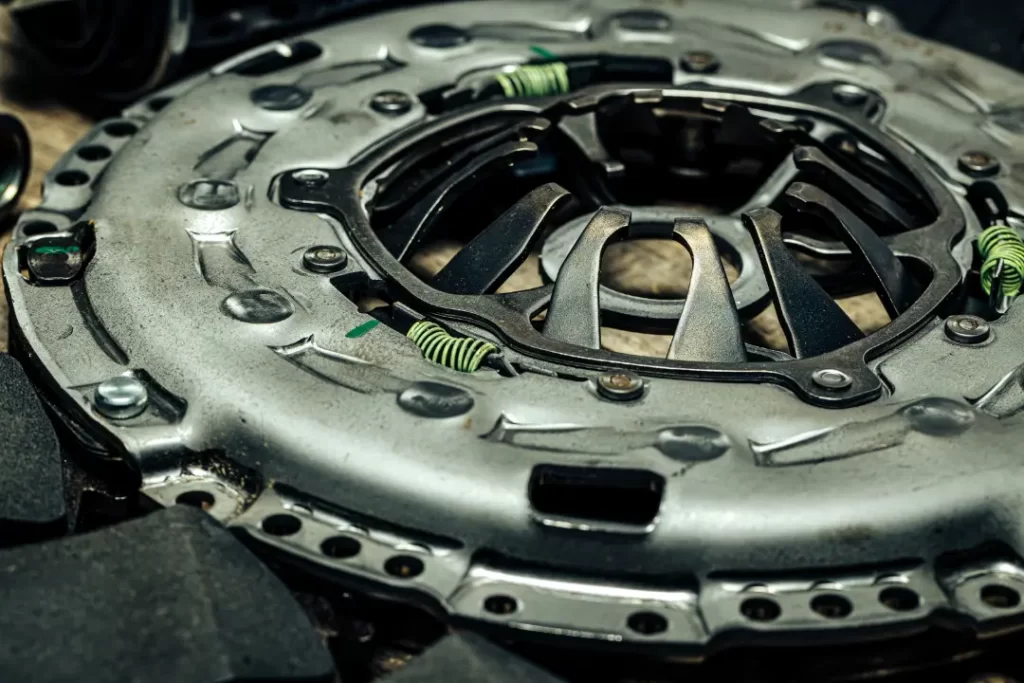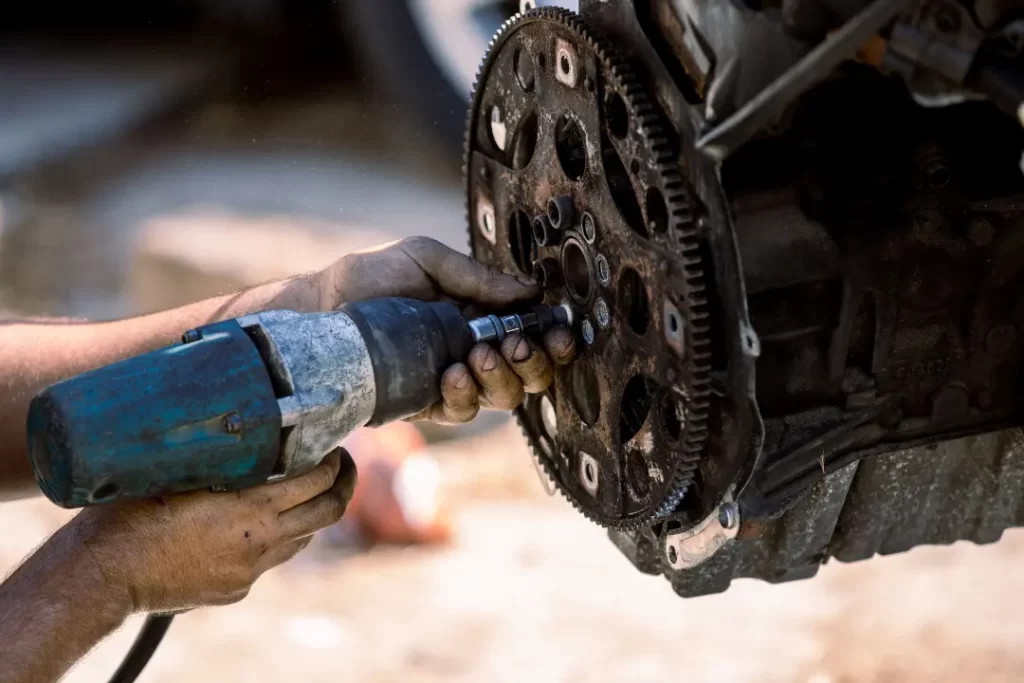How long does it take to replace a clutch in most vehicles? Generally it might take roughly 3 to 6 hours, though this can vary.
Vehicle type, mechanic skill, and equipment all influence the timeline. In this article, we will discuss these elements to clarify what determines clutch replacement duration, providing you with essential knowledge for your specific situation.
Key Takeaways
- Clutch replacement takes approximately 3-6 hours, but this can vary significantly based on vehicle complexity, mechanic expertise, and equipment used. Newer and more complex vehicles, like those with DSG and dual-mass flywheels, require more time for a clutch change.
- A mechanic’s efficiency, experience, and availability of specialised tools and diagnostic equipment can accelerate the clutch replacement process, ensuring quality service and a quicker return to road readiness for the vehicle.
- Labour costs can significantly impact the overall cost of a clutch replacement, with rates varying depending on the region, vehicle make and model, and additional complications encountered during the service.
- Clutch repairs, including replacements, are essential for maintaining vehicle performance and safety.
Introduction to Clutch Replacement
Clutch replacement is a crucial process that involves removing the old clutch and installing a new one. The clutch is a vital component of a vehicle’s transmission system, responsible for engaging and disengaging the engine power to the transmission, allowing for smooth gear transitions. When the clutch becomes worn out or damaged, it can lead to various driving issues, making replacement necessary to restore optimal performance.
Typically, a clutch replacement can take anywhere from 2 to 10 hours to complete. The exact time depends on several factors, including the type of vehicle, the complexity of the clutch mechanism, and the experience of the mechanic. For instance, vehicles with more complex systems, such as those with dual-mass flywheels, may require more time compared to simpler setups.
The cost of labour for a clutch replacement can also vary per hour. This variation depends on the mechanic’s expertise and the location of the service. Additional repairs that may be needed during the process can also affect the total time and cost.
Understanding these factors can help you prepare for the clutch replacement process and ensure you receive a fair and accurate estimate.

What Are the Symptoms of A Failing Clutch?
A failing clutch can exhibit several symptoms that indicate it’s time for a replacement. One of the most common signs is a spongy or soft clutch pedal, which can make it difficult to change gears. You might also notice slipping or hesitation when accelerating, where the engine revs but the vehicle doesn’t gain speed as expected. Additionally, grinding or screeching noises when shifting gears can signal that the clutch components are worn out.
Ignoring these symptoms can lead to complete clutch failure, making the vehicle unsafe to drive. When a clutch fails, it can no longer effectively engage and disengage the engine power, leading to a loss of control over the vehicle’s movement. In such cases, a clutch replacement becomes necessary to restore the vehicle’s performance and safety.
By addressing clutch issues promptly, you can avoid further damage and ensure your vehicle remains reliable and safe to drive.
What Are the Factors that Affect Clutch Replacement Duration?
Understanding these factors will help manage your expectations and ensure you’re not caught off guard by how long it takes to regain your clutch and freedom.
Vehicle Type and Complexity
The process of clutch replacement begins with your vehicle. Vehicles with easily accessible clutches can significantly reduce the time required for replacement.
Is it a modern car with an advanced Direct-Shift Gearbox (DSG) or a simpler rear-wheel-drive model? The time needed for clutch replacement can vary based on the vehicle make and model, with more complex or newer vehicles generally requiring more effort and time.
Rear-wheel-drive vehicles often provide easier clutch access, leading to shorter replacement times compared to front-wheel-drive models. For vehicles equipped with a DSG and dual mass flywheel, expect more complexity.
Due to their specific design and operation, these dual-clutch systems can increase the time needed for clutch replacement. It’s necessary to consider the details of these systems when replacing them.
Mechanic Expertise and Efficiency
Once you understand how vehicle type affects the time it takes to replace a clutch, it’s important to acknowledge the role of mechanics. Experienced mechanics not only perform clutch replacements but also handle clutch repairs, ensuring thorough service. The technician’s experience and skill directly impact the time needed for the job. Our skilled technicians at Ivydene Garage Ltd. enhance the efficiency and precision of your vehicle’s service.
It’s not only about working quickly. Expert mechanics also provide high-quality service that can significantly impact your experience. This mix of speed and skill can simplify the replacement process, helping you return to driving as soon as possible.
Equipment and Tools
A garage with modern diagnostic and service tools is essential for performing clutch replacements efficiently. A mechanic with access to a lift and air tools can quickly elevate the vehicle and remove bolts accurately. This equipment can make the task easier and more efficient.
However, having the right tools is not enough; it’s also essential to know how to use them properly. The right combination of equipment and skill can significantly reduce your car’s time in the shop and increase the time it spends on the road. That’s why you need expert mechanics.
The Importance of Clutch Maintenance
Regular clutch maintenance is necessary to prevent damage and ensure smooth gear transitions. The clutch pedal, hydraulic system, and clutch disc must be checked often for wear or damage. Maintenance involves inspecting these parts and fixing any problems before they worsen.
A vital part of clutch maintenance is keeping the hydraulic system functional. This means using the correct clutch fluid and regularly bleeding the system to eliminate air pockets that can affect performance. Ignoring this can result in a spongy or unresponsive clutch pedal, making it hard to shift gears and possibly damaging the transmission.
By keeping up with clutch maintenance, you can prolong the life of your clutch and avoid expensive repairs. Regular checks and prompt fixes can help your vehicle run well, ensuring the clutch works correctly and improving the overall condition of your transmission system.
Step-by-Step Breakdown of Replacing a Clutch
Replacing a clutch requires careful preparation. Here are the steps involved in the process:
Remove the Old Clutch
A procedure must be followed before the old clutch is replaced. It starts with ensuring the car is parked on a level surface with the parking brake engaged. Follow these steps carefully:
- Lift the vehicle with a hydraulic jack and secure it on jack stands to provide enough clearance for the task.
- Disconnect the positive battery cable to signify the beginning of the procedure.
- Raise the front end of the car and stabilise the engine.
What follows is a series of removals:
- The transaxle
- The drive axle
- The prop shaft
- The pressure plate
These components must be carefully removed to access the old clutch located under the car. This process requires patience and precision to ensure every bolt and bracket is accounted for and every connection is properly disconnected.
Install the New Clutch Kit
With the old components removed, it’s time to introduce the new clutch kit, which includes essential parts for your vehicle’s transmission system. First, the flywheel is installed to provide a stable base for the clutch disc and pressure plate to be positioned and secured. Ensuring that each piece is aligned correctly is crucial for proper engagement and disengagement.
However, the setup isn’t complete just yet. The new release bearing needs to be greased before the transmission is reattached, and the transaxle carefully aligned to ensure that the shaft fits correctly into the clutch disc.
This moment marks the successful assembly of the components, highlighting the careful preparation and skill involved in this process.
Post-Replacement Checks and Tests
After the installation is complete, it’s time for the post-replacement checks and tests. Aligning the transaxle in the spline hole is essential for the clutch’s performance. Next are the tests to confirm that the clutch operates correctly, including measuring flywheel run-out, checking the crankshaft end float, and inspecting the crankshaft flange.
It’s also important to bleed the hydraulic clutch system to remove air pockets. This step ensures that the clutch functions effectively, ready for road use.
Time-Saving Tips for Clutch Replacement
Time is crucial for clutch replacements, and efficiency is essential. Knowing the process and having the right tools can help avoid delays from unexpected problems.
Consider using auxiliary lifting devices instead of a traditional car lift to save time and streamline the clutch installation. Organising your bolts and components will also aid in reassembly after replacement.
By arranging tools and parts in advance, you’ll minimise downtime and maximise efficiency, ensuring the clutch replacement process is as smooth as the new clutch.

The Cost Factor: How Labour Costs Affect Timing
The cost of clutch replacement is not just about the parts; labour plays a substantial role in the final bill. The cost of clutch repairs, including replacements, is influenced by labour rates and the complexity of the job. In the UK, labour costs can swing widely, influenced by the car’s make, model, age, and any additional complications that may arise. These costs are also subject to regional variations, meaning the price may differ depending on where you are in the UK.
Garages base their labour rates on the anticipated time to complete the job. Since clutch replacements are labour-intensive, especially with manual transmission systems, labour constitutes a significant portion of the cost. It’s worth considering when budgeting for the service, as the hours spent under the hood will directly impact your wallet.
Clutch Replacement and Vehicle Performance
Clutch replacement can significantly impact a vehicle’s performance, particularly in terms of gear shifting and acceleration. A new clutch can improve the vehicle’s responsiveness, making it easier to change gears smoothly and efficiently. This enhancement not only provides a better driving experience but also contributes to the overall safety of the vehicle.
In addition to improving gear shifting, a new clutch can also enhance the vehicle’s fuel efficiency. A worn-out clutch can cause the engine to work harder, leading to increased fuel consumption. By replacing the clutch, you can ensure that the engine power is transmitted more effectively to the transmission, reducing the strain on the engine and improving fuel economy.
However, clutch replacement is a complex process that requires specialised tools and expertise. It’s recommended that you seek the services of a qualified mechanic to ensure quality service and an accurate estimate.
Professional mechanics have the experience and equipment needed to perform the replacement correctly, minimising the risk of further damage and ensuring that your vehicle performs at its best.
By investing in professional clutch replacement, you can enjoy a smoother, more efficient driving experience and extend the life of your vehicle’s transmission system.
When to Consider a Full Transmission Service
While clutch replacement is a significant undertaking, it’s also an opportunity to consider the broader health of your vehicle’s transmission. A full transmission service, combined with clutch replacement, is a strategic move for those who plan to keep their vehicle for the long haul or subject it to demanding conditions.
For vehicles destined for a lengthy service life or potentially handed down to the next generation, scheduling transmission services between 30,000 and 50,000 miles is a wise preventative measure. For those who frequently engage in towing, changing transmission fluid every 30,000 miles, or sooner if overheating is a concern, can stave off future problems.
Similarly, larger trucks bearing heavy loads should have their transmission fluid checked and possibly changed at similar intervals, particularly if they operate in extreme conditions.
DIY vs. Professional Clutch Replacement
Whether to replace your clutch as a DIY project or entrust it to a professional is a decision that shouldn’t be taken lightly. While saving on labour costs is tempting, the complexities of clutch replacement often lead DIYers down a path fraught with errors and complications.
For instance, an incorrectly installed clutch plate can result in a lack of drive and unwelcome screeching noises, while unaddressed oil leaks can cause the new clutch to slip prematurely.
Inexperience can also lead to improper adjustments of the clutch pedal freeboard or slave cylinder push rod, causing the clutch to disengage incorrectly.
Moreover, improper handling of components could bend the clutch plate hub, leading to judder and gear selection issues.
These potential pitfalls underscore the importance of having a professional handle the replacement, ensuring that the job is done right the first time and sparing you the agony of repeat repairs.

Ivydene Garage Ltd.: Your Trusted Garage for Clutch Replacements in Ashford
At Ivydene Garage Ltd., we specialise in high-quality clutch replacements and repairs, with over 3 decades of experience serving vehicle owners across the West Midlands.
We combine old-school mechanical knowledge with modern diagnostic tools to give your car the precision care it deserves.
Whether you drive a manual hatchback or a high-performance DSG-equipped vehicle, our team knows how to get it done efficiently and correctly.
Here’s why motorists choose us every time:
- Experienced technicians who know the intricacies of all makes and models
- State-of-the-art tools for faster, more accurate repairs
- Transparent pricing with no hidden fees
- Excellent turnaround time and customer support
We’ve built our reputation on reliability, honesty, and a deep understanding of what our clients need. When it comes to something as vital as your clutch, trust our experts who do it best. Book your vehicle in with Ivydene Garage Ltd. today and let our experienced team handle the rest.
Common Questions About Clutch Replacement
When the moment arrives and your clutch starts to fail, several questions may come to mind.
What are the signs of a failing clutch? What does it mean when the clutch pedal feels different, or shifting gears becomes difficult?
The clutch, which connects the engine and transmission, is essential for smooth gear changes. Unusual noises, like growling or squeaking when pressing the clutch pedal, or a soft and spongy feel underfoot, can indicate clutch problems.
If you’re having trouble with gears that won’t shift properly or a pedal that sticks to the floor, it may be time to check for issues with the clutch’s release mechanism or linkage.
Additionally, a burning smell while driving, especially when using the clutch, or an engine that revs without accelerating, suggests clutch slippage and needs immediate attention. It’s important to notice these symptoms early, as they could indicate an impending failure that requires quick action.
Some common symptoms of clutch problems include:
- Gears that refuse to shift smoothly
- A pedal that sticks stubbornly to the floor
- A burning smell during driving, particularly when the clutch is in use
- An engine that revs without proper acceleration
If you notice any of these symptoms, it’s important to have your clutch checked by a professional as soon as possible.
Summary
Clutch replacement is a multifaceted process influenced by various factors, such as vehicle complexity, mechanic expertise, and the quality of parts used.
Understanding these elements and recognising the signs of clutch failure and the advantages of professional over DIY replacement is key to ensuring a smooth and efficient service.
With Ivydene Garage Ltd.’s proven track record and commitment to excellence, you can rest assured that your vehicle is in the hands of professionals who will confidently get you back on the road.
Frequently Asked Questions
What is a Direct-Shift Gearbox (DSG)?
A Direct-Shift Gearbox (DSG) is an advanced dual-clutch system that offers swift and smooth gear changes, blending manual transmission efficiency with automatic convenience.
How long has Ivydene Garage been a Bosch agent?
Ivydene Garage Ltd has been a Bosch agent for over 32 years, demonstrating their long-standing commitment to quality and excellence in automotive services.
What types of vehicles are suitable for Class 4 MOT tests?
Class 4 MOT tests are suitable for cars, small vans, and motor caravans weighing up to 3,000kg (3 tonnes), ensuring they meet safety and environmental standards.
What should I consider before replacing my car’s clutch?
Before replacing your car’s clutch, it’s important to have all the necessary tools—including a clutch alignment tool and to inspect the clutch linkage and pilot bearing for wear. Replacing with the original clutch and all the parts ensures seamless gear transitions and prevents future clutch damage. Many drivers also consult a mechanic for a more accurate estimate before starting the job.
